Camp Games
Family or group camping traditions often include games. One of the biggest enjoyments in camping is leaving modern conveniences behind and roughing it out in the great wild. This includes leaving behind television, movies and video games and other entertainment. Even today, when mobile devices make it possible to bring these along, isn’t it good to spend some time unplugged?
Camp games can fill the space between hiking, fishing, meals and other activities. It’s good to plan for games that can be played outdoors as well as indoors (in the tent or at a table) after dark, or when the weather doesn’t cooperate and everyone needs something to do.
Ladder Ball
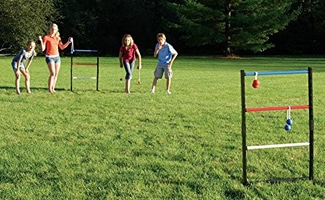 We’ve resisted posting this perennial camp favorite. But ladder ball is great family fun, and if you haven’t played it at camp, you’re missing out!
We’ve resisted posting this perennial camp favorite. But ladder ball is great family fun, and if you haven’t played it at camp, you’re missing out!
Also called Ladder Golf, this game for 2 to 4 players is played by throwing bolas (two balls connected by a string) onto a ladder-shaped upright. Scoring depends on which ladder rung your bola wraps around.
You can place the 2 ladders close or far apart, which makes the game adaptable to any size space, lawn or campsite.
We like this version sold by Amazon because the uprights are made of metal and the whole assembly is durable and made to last. It includes instructions and a storage/carrying bag.
Fun for kids and adults to play together.
Five Crowns
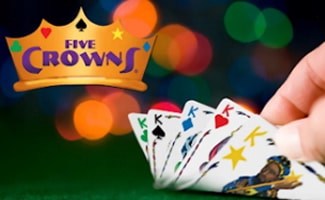 Playing cards and camping make a classic combo. That’s why we’re always on the lookout for a new card game to recommend. This one’s an award winner and so fun to play, you won’t want to quit until long past quiet time. It’s that addicting!
Playing cards and camping make a classic combo. That’s why we’re always on the lookout for a new card game to recommend. This one’s an award winner and so fun to play, you won’t want to quit until long past quiet time. It’s that addicting!
Be the first to go out, then watch the others scramble as they get one last chance to cut their losses. Five Crowns, with its beautiful cards, is easy to learn. It starts with 3 cards and 3’s are wild. The next hand has 4 cards and 4’s are wild, and so on.
You’ll need luck and skill throughout the game because, even in the last hand, a worthy opponent can come from behind and win. Remember, “the game isn’t over ’til the Kings go wild.”
Fun for kids and adults to play together.
Perudo
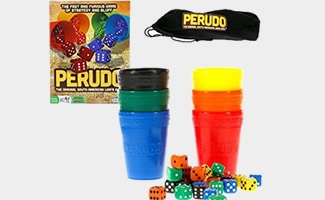 Dice games are perfect for camping. This one’s a great game you might remember seeing a variation of in the second “Pirates of the Caribbean” movie.
Dice games are perfect for camping. This one’s a great game you might remember seeing a variation of in the second “Pirates of the Caribbean” movie.
Each player rolls the dice in their cup, then turns their cup upside down with the dice still inside. They then take turns bidding on how many dice they think are showing a certain number. You can bid on any one of the six numbers on the dice, but you have to increase the bid with each turn.
If it’s your turn and you think the previous player’s bid is too high then you say “dudo” (Spanish for “I doubt it”). At that point everyone lifts up their cups and counts the total number of dice showing the number the player bid on (ones are wild).
If you’re right about saying “dudo”, then the player who made that bid loses a die. However, if you say “dudo” and are wrong, then you lose a die. In other words, it’s real important you make a bid that doesn’t sound too high to the next player.
The object of the game is to be the only remaining player with at least one die left in your cup.
Mexican Train
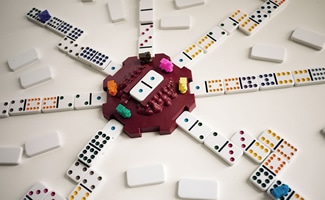 We were first introduced to Mexican Train during a July 4th campout near Lake Tahoe. It’s the only version of dominoes we play now. And it’s especially fun at camp. Not sure why, but isn’t just about any game more fun at camp?
We were first introduced to Mexican Train during a July 4th campout near Lake Tahoe. It’s the only version of dominoes we play now. And it’s especially fun at camp. Not sure why, but isn’t just about any game more fun at camp?
The Mexican Train version of dominoes is enjoyed by millions of Americans, and if you’re not one of them, you’re missing the train! It gets its name from the game layout that resembles “trains” coming out from a central station. Also from the “wild” Mexican Train line of dominoes that all players can jump on and use.
It’s easy to learn and fun for everyone, ages 6 and up, and for 2 to 8 players. Here’s the rules, or here or here and a gameplay video.
You can play Mexican Train with regular dominoes, using pennies (as we do) or buttons, stones, etc. for markers.
Dedicated Mexican Train domino sets are available too. Here’s the most popular set sold on Amazon, but you may like this smaller travel set with a zipper pouch for camping–it also uses numbers instead of dots on the tiles, which some people say makes gameplay easier.
Deer in the Headlights
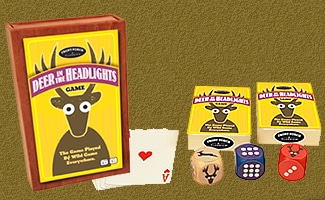 This game’s fun back-country title drew our attention like… well, a deer in the headlights! This fast-moving card and dice game has no real strategy, so even the youngest players can win. But judging by users comments over on Amazon, adults and teens are Deer in the Headlights fanatics.
This game’s fun back-country title drew our attention like… well, a deer in the headlights! This fast-moving card and dice game has no real strategy, so even the youngest players can win. But judging by users comments over on Amazon, adults and teens are Deer in the Headlights fanatics.
To win each round, be the first to discard all your cards. But watch out. A ”Deer in the Headlights” roll will stall your progress. If you roll a ”Car” or ”Running Deer”, you can dump cards on your opponents. This goofy game is easy to learn. The compact set makes it easy to take along on car trips or camping trips.
Comes with 2 decks of cards. Use one for 2-4 players or both decks for up to 8 players. Add a pencil for keeping score.
Bocce
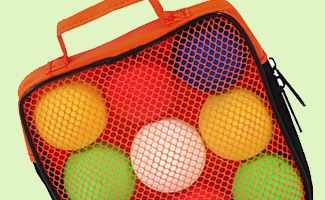 Maybe it doesn’t take us to mention Bocce (BAH-chee, or BOH-chay if playing with Italians) as a great game to play at camp. It has become so popular you’ve probably already played it.
Maybe it doesn’t take us to mention Bocce (BAH-chee, or BOH-chay if playing with Italians) as a great game to play at camp. It has become so popular you’ve probably already played it.
If you haven’t played Bocce, try it on your next campout. The rules are super easy, and anyone of any age or physical skill can play.
Bocce is a relaxed but strategic game played officially on a Bocce court, but any open outdoor space, and almost any terrain, will do. All you need is a Bocce set, consisting of one small ball (pallino or jack ball) and 8 larger balls. Buy a set at any sporting goods store or online.
Pictured above is a Bocce set made especially for backpacking. The balls are smaller and lighter than regulation balls, which—along with the flexible zipper pouch—make the set convenient for travel, camping and backpacking. For beginners wanting a regular sized set, thisfamily starter setor Amazon’s #1-selling Bocce set make good choices.
To get the gist of how to play Bocce, watch this brief video. To learn how to play, read these rules.
Nature's Tic-Tac-Toe
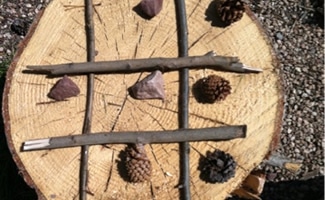 Easy game idea for camp. Kids have fun collecting their own game pieces from nature.
Easy game idea for camp. Kids have fun collecting their own game pieces from nature.
Create the game board on a picnic table, on the ground, or anywhere, using sticks or twigs for cross bars.
Markers can be stones, leaves, bits of bark, blossoms, or other objects. Each player needs 5 markers of the same type (5 stones, 5 leaves…).
Tic Tac Toe is a simple game which, if played perfectly by both players, always ends in a tie. But many players (especially younger children) still enjoy playing. It’s an ancient game and is played all around the world.
How to Play
- Decide who moves first.
- Players take turns placing a marker in any empty space.
- The first to make a line from one side or corner of the board to the other – 3 in a row – wins.
- When all pieces are placed without making 3 in a row, game ends in a tie.
Variations
Higher Math Tic-Tac-Toe: Use a 4×4 grid. Win with 4 in a row. Larger grids can be used, for example 5×5 or 6×6, but 4 in a row still wins.
Your Choice Tic-Tac-Toe: Each player may put down either an (X) or (O) on each of their turns, and may change their mind from turn to turn. The winner is the one who finishes any row, column, or diagonal of all (X’s) or all (O’s).
Toe-Tac-Tic: Same order of play as the standard game, except that a player who completes 3 in a row loses.
Drawbridge Tic-Tac-Toe: Same order of play as the standard game, except one player wins if the game is a tie, while the other wins if either completes 3 in a row.
Movable Marker Tic-Tac-Toe: Players have 3 markers each and take turns placing them on the grid. If neither has won after all 6 markers are down, players may move one of their markers somewhere else as their move.
Multi-Player Tic-Tac-Toe: For three to six people, try a giant board, one that is at least 10×10. Four in a row wins.
Spot it! Gone Camping
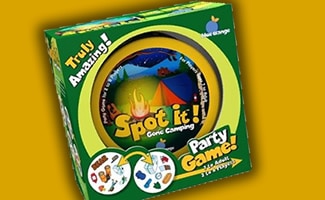 Fun for kids and adults, this Gone Camping edition of the popular Spot it! card games is great for camp or home. Here’s the description from Amazon:
Fun for kids and adults, this Gone Camping edition of the popular Spot it! card games is great for camp or home. Here’s the description from Amazon:
“Spot it! is a one-of-a-kind card game for every generation. It consists of 55 circular cards each decorated with eight symbols varying in size and orientation. Here’s the catch: there is always one and only one matching symbol between any two cards. Spot it to win! Race to find matches between gear, critters, nature, and more. Whether you’re cozy in a cabin, roughin’ it in a tent, or just in your own back yard, Spot it! Gone Camping captures everything you love about camping out.
“Players can choose from five mini-games with different rules and objectives. In some you race to collect cards, in others you try to get rid of cards. The action moves fast and everyone plays at the same time. The sturdy little game tin is easy to take along on all your adventures and guarantees instant fun!”
Checkers
Few activities are as classic as a game of checkers on a lazy afternoon at camp. Too boring, you say? Checkers may be simple and can be slow paced, but that’s what makes it perfect for camp! You’re away from home, from technology, from clocks and schedules. Checkers fits right in. Kids enjoy it, and adults can have a good conversation over a game of checkers.
Did you know checkers is called “draughts” outside the US? If you need them, here’s the rules for playing checkers.
There are checkers apps for mobile devices, but don’t you dare! At camp, everything should be hands-on. To help you preserve that historic aspect of this centuries-old game, we searched out some DIY checkers ideas and also rounded up some checkers offering we like from Amazon.
DIY Checker Games
You don’t need to buy a game board and pieces. There are many ways to make them yourself.
For example, pictured, is a board drawn with chalk. At camp you could draw a board on the picnic table or back of a table covering. Use light and dark stones for playing pieces. You could draw a board on the inside of a paper bag, using a pen or marker. Colored buttons or pennies and nickels make easy game pieces. Create a reusable board with permanent markers on a square of burlap or other heavy cloth. Roll or fold it for storage. For playing pieces, we like these wooden ones in a drawstring bag.
Shop for Checkers
We like these checker sets available from Amazon. We selected sets we think work well for camping based on various criteria.
Jumbo Checkers Rug – (shown) It’s reversible with Tic Tac Toe on the back. Easy to roll up and transport. Large size makes it fun to play.
Solid Wood Checkers Set – Wood for tradition, durability and outdoorsy feel. Has slots to hold playing pieces.
Magnetic Travel Checkers – Only 5 inches square, fits in a backpack. Magnetic pieces stay in place. Zipper pouch with cord handle.
3 in 1 Set – Includes checkers, chess and backgammon. All pieces store inside the foldable wood case.
Marshmallow Shooter
 Simple outdoor fun plays a big part in creating lasting camp memories. Can’t get much simpler than these easy to make marshmallow shooters.
Simple outdoor fun plays a big part in creating lasting camp memories. Can’t get much simpler than these easy to make marshmallow shooters.
Cut the bottom off a sturdy plastic cup. Tie a knot in a balloon. Cut off the bottom of the balloon and stretch it over the lip of the cup. Twelve-inch balloons work best.
If the cup collapses, use two nested cups. Water or soda bottles work, too, with the balloon knot at the spout end.
To launch mini-marshmallows, load one into the cup, pull the knot back, release and let it fly.
Ideas for Play
Draw a line in the dirt. Players stand behind the line and try to launch marshmallows into circles drawn in the dirt or try to hit camp items set on the table. See who can launch a marshmallow the farthest.
Players can take sides and try to land marshmallows in each other’s mouths (not safe for small children who may choke), or up in the air and into their own mouths.
One player (Dad makes a good target) sits still as players score points for hitting various parts like chest, forehead, nose, ear, etc.
Using colored marshmallows—each player with his or her own color—see which player can land the most marshmallows in a camp pot set on the table or ground.
EVERYONE HELPS CLEAN UP! When the fun ends, don’t leave marshmallows lying around to make a sticky mess, attract insects or as an unhealthy snack for wildlife.
Ring Toss X 2
Ring Toss is fun for every age and makes a good game for camp. You can make up your own rules, use points or not, change it up to make it easy or hard. Here’s 2 ways to make your own ring toss game:
Paper Plates
Easy to make right in camp with stuff you’ve probably got on hand. You could even improvise if you don’t have scissors, tape or an empty paper towel tube. Make paper plate ring toss part of a plan or turn to it when there’s a lag in activity and the kids need something to do.
 Glow In The Dark
Glow In The Dark
Drop some glow sticks into water bottles, use glow-stick bracelets or necklaces for rings, and you’ve got an enjoyable after-dark version of ring toss! You can snap bracelets together to make larger glow rings.
Chubby Bunny
 Chubby Bunny is hilarious due to the ridiculous object of the game and because nobody can play or watch without completely cracking up. It’s a perfectly suitable game for camp because it needs only two things to play—both common to most campouts: 1) marshmallows and 2) people willing to be silly for the entertainment of others.
Chubby Bunny is hilarious due to the ridiculous object of the game and because nobody can play or watch without completely cracking up. It’s a perfectly suitable game for camp because it needs only two things to play—both common to most campouts: 1) marshmallows and 2) people willing to be silly for the entertainment of others.
The rules are simple. Players take turns placing a marshmallow in their mouths and saying “chubby bunny.” For each round another marshmallow is stuffed in (later crammed in) followed by the attempted “chubby bunny.” To qualify for the next round, the phrase must be spoken clearly—all vowels and consonants in place and understandable.
The winner is the person who can enunciate the two words with the most marshmallows in his or her mouth. Yes, studies show that actual fun can result from people’s collective efforts not to laugh so uncontrollably as to cause mass marshmallow ejections from the group.
Build a Fairy House
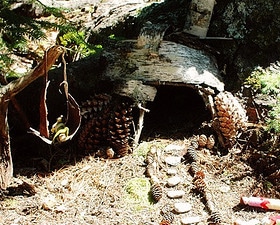 This fun project for kids keeps their hands and their imaginations busy. It also provides a tiny resting place for travelling fairies who appreciate a small cozy shelter.
This fun project for kids keeps their hands and their imaginations busy. It also provides a tiny resting place for travelling fairies who appreciate a small cozy shelter.
You’ll need sticks, bark, pinecones, pebbles, or any small natural materials such as leaves or feathers that have fallen to the ground.
Pick a safe, protected spot for your fairy house, like against a tree or fallen log. Poke sticks and bark into the ground or prop them against each other for walls and to hold a roof in place. Use your imagination according to the materials you have.
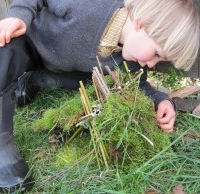
Decorate as needed and think about adding details such as a pathway or little fence.
When the house is finished, tuck a house-warming present inside such as a little flower or acorn cap filled with water.
Find the Wierdest

An easy game to plan ahead or use when kids get rowdy or bored and need some structure.
The object of the game is to see who can find the weirdest, the biggest, the smallest, the ugliest leaf or bug or rock, etc.
Give all kids the same object to search for. Round 1: “Who can find the weirdest leaf? On your mark, get set, go!” Then pick a winner when they return. Round 2: “Who can find the ugliest rock?” etc.
You can set paper plates out for kids to write their names on. Each kid brings their found object back and puts it on his or her plate to display for judging.
Give a short time limit such as 3 or 5 minutes for each object.
Option: play in teams.
Option: write objects on slips of paper and have kids draw to see what they must find.
It’s important to set limits to where kids can search, depending on ages (for example, only where we can see you, anywhere but near the river, only in our campsite, etc.).
Adults might accompany small children on the hunt.
Skin the Marshmallow
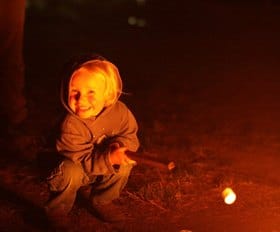
While toasting your marshmallows on a stick over the coals, see who can skin their marshmallow the most times. Toast your marshmallow to the point where you can pull off just the outermost toasted layer. Toast the remainder lightly until you can pull off its outer skin. Repeat until you have skinned your marshmallow down to nothing. Don’t forget to count how many times you skinned the same marshmallow. We’ve heard of a personal record of 13 skins. Can you match that?
This is a Spoon
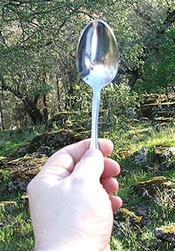
This game is a classic party game that’s fun to play around the campfire, or camp table. We’ve heard of 2 versions, both are fun and get people laughing. Version A is a little easier and especially fun with kids. Version B is more complex and works great with teens and adults.
Version A
1. The group sits in a circle.
2. Person #1, holding a spoon, says to person #2, “This is a spoon.” Person #2: “A what?” Person #1: “A spoon.”
3. Person #2 takes the spoon and says to person #3, “This is a spoon.” Person #3: “A what?” Person #2 to person #1: “A what?” Person #1: “A spoon.” Person #2 to person #3: “A spoon.”
4. Person #3 takes the spoon and says to #4, “This is a spoon.” #4: “A what?” #3 to #2: “A what?” #2 to #1: “A what?” Person #1: “A spoon.” #2 to #3: “A spoon.” #3 to #4: “A spoon.”
5. And so on all the way around the circle—“A what?” always getting relayed back to #1, and “A spoon” relaying down to the person next to take the spoon.
6. When the group has this down, person #1, immediately after passing the spoon to #2, starts a fork going in the opposite direction. Let the laughing begin.
Version B
1. The group sits in a circle.
2. Person #1, holding a spoon, says to person #2, “This is a spoon.” Person #2: “A what?” Person #1: “A spoon.” Person #2: “A what?” Person #1: “A spoon!” Person #2, taking the spoon: “Oh, a spoon!”
3. Person #2 to person #3: “This is a spoon.” Person #3: “A what?” Person #2: “A spoon.” Person #3: “A what?” Person #2: “A spoon!” Person #3, taking the spoon: “Oh, a spoon!”
4. Person #3 repeats the process with person #4 and so on around the circle.
5. Here’s where the fun begins. As soon as person #2 has passed the spoon to person #3, person #1 starts again with the same person #2, using a different object. Person #1: “This is a fork.” Person #2: “A what?” Person #1: “A fork.” Person #2: “A what?” Person #1: “A fork!” Person #2, taking the fork: “Oh, a fork!”
6. Play continues with 4 or more objects, depending on how many people are in the circle, and how crazy you want things to get!
Here’s a video showing Version B. It starts at the point in the game where all objects (same number as there are people in the circle) are in play.
Fan Tan
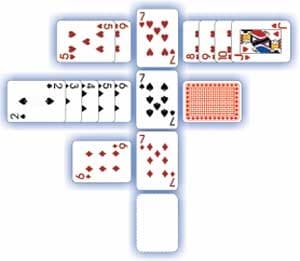
Card games are always fun at camp. This is an old classic that’s easy to learn.
To Win: Play all your cards.
Fan Tan can be played with 3-8 players, but 4 is best.
You’ll need a regular deck of cards and poker chips (or dried beans, pebbles, pennies). Deal the cards one at a time to the players. It doesn’t matter if some players end up with one fewer than others.
Beginning with the player to dealer’s left, each player must play a 7 or else add on to cards in suit sequences ascending or descending from the 7s.
Once the 7 has been played, for example, the 8 and 6 of the same suit can be played. If the 8 is played, you can play the 9. If the 6 is played, you can play the 5.
Sequences ascend to the king on one side of the 7 and descend to the ace on the other. Once an end card is reached, fold up the row of cards and turn them over.
Whenever you can’t play one of your cards, pass and toss one chip into the kitty (bowl, pile, plate). Whoever is out of cards first collects the chips in the kitty, plus one chip per card left in each player’s hand.
At the end of the game (play lasts as long as players want), the one with the most chips wins.
Fan Tan can be played without chips by simply keeping track of how many hands each player wins.
Tips: Try to encourage play in suits where you have aces or kings. Your goal is to be able to hold back stoppers — the 5s, 6s, 8s and 9s that block everyone else’s cards but not your own. If your timing is right, the suits you need help in will open up before your stoppers are gone.
Scavenger Hunt
Object of the game: Be first to find all or the most items from a list.
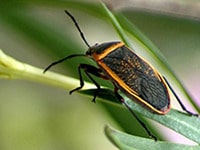
Everyone likes scavenger hunts. They can be especially fun at camp where the out-of-doors provides interesting items to search for and often create fun adventure along the way.
The general idea is to split your family or group into pairs or teams. Each receives an identical list of objects to search for. The first team to return having found all the listed items, wins.
A variation is to give a time frame (45 minutes, or whatever) and apply points to each listed item. Easy items to find earn 1 point, medium 2, and hard 3. The team with the highest score when time is up, wins.
A low-tech scavenger hunt might use checklists and pencils. A high-tech hunt might include taking pictures or recording videos on your phone or camera.
Important considerations are supervision and safety for children or teens. Players should respect other campers and the environment.
Ready-to-print scavenger hunt of items found at American River Resort.
I Took A Trip or He Who Laughs Last
Object of the game: be the last to laugh.
- Everyone sits in a circle and someone is chosen as leader.
- The leader asks each player in turn: “I took a trip. What did I take with me?” Each player gives an answer (can be anything, a camera, purple lipstick, a big gorilla, etc.).
- The leader asks a second question to each player. The players must give the same answer as before but without laughing. The second question might be, “I took a trip. What did I eat for breakfast?” or “I took a trip. What did I wear on my feet?”
- Whoever laughs is out. The leader keeps asking questions until one person is left not laughing. That person is the next leader of the game.
- Obviously, the leader tries to come up questions that will make the given answers seem funny or silly.
